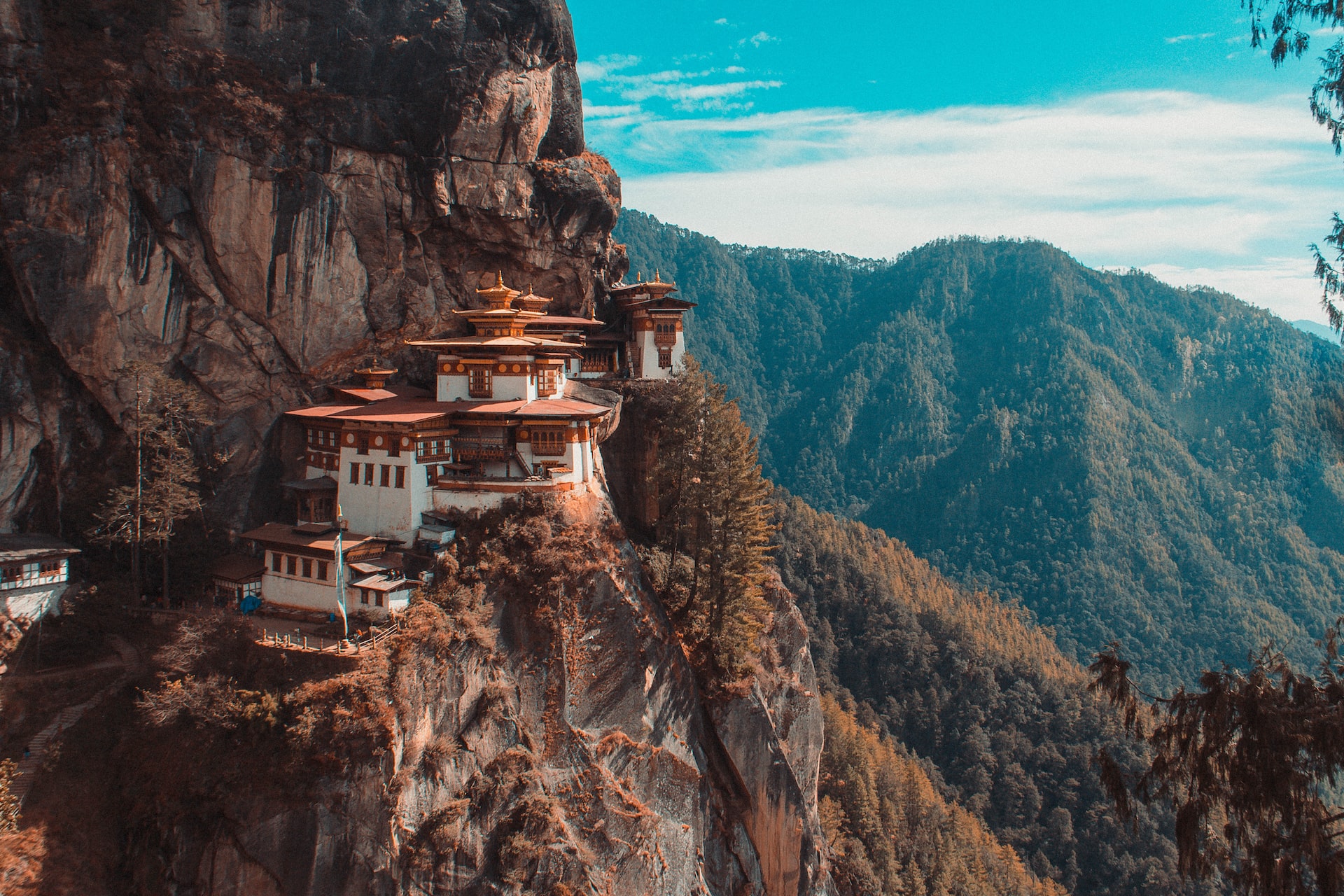What happens when an entire country commits to playing within its social and ecological limits?
To find out, we asked a key figure in Bhutan’s tourism sector. This small kingdom in the Himalayas seems to have found the answers to many of today’s tourism challenges 50 years ago. Bhutan’s modern tourism industry began welcoming visitors in the 1970s, long before the dramatic, global growth of mass tourism. The UNWTO estimates that there were an estimated 6.2 million international arrivals within the Asia & Pacific region in 1970. By 2018, that annual number had grown to 323 million. And since the beginning, Bhutan’s national policies have prescribed a set amount of visitation while making sure the public benefits from the profits. It’s a unique example of destination management with profound lessons for places looking for a new path forward.
In this episode of the Travel Beyond (formerly Think Revelstoke) podcast, our hosts speak with Damcho Rinzin of the Tourism Council of Bhutan. He joins us to share:
- Principles Bhutan has used to shape its tourism industry.
- Why Bhutan’s Sustainable Development Fee (STF) was put in place.
- How Bhutan has responded to growing demand and overcrowding at some sites.
- How Bhutan’s brand helps it attract respectful visitors.
- Recent changes in light of increasing demand and recovery from COVID-19.
Listen to this episode and subscribe to Travel Beyond on Spotify, Apple Podcasts, or through your favourite podcast player.
Feature image: Aaron Santelices on Unsplash
Show notes
Tourism Council of Bhutan – The organization responsible for promoting and managing tourism in Bhutan.
Links to stories about changes to Bhutan’s Sustainable Development Fee:
- It’s now cheaper for travelers to go to Bhutan — if they stay long enough (CNBC)
- Bhutan Lowers Sustainable Fee To Boost Longer Stays From Tourists (Skift)
- Bhutan achieves record-breaking tourism earnings (The Nation)
Episode transcript
Damcho Rinzin: Bhutan is such a small country and it’s a landlocked, mountainous country. We only have a limited habitable, valley. So if you had a lot of tourists come in. There’s no space for the locals. There’s a lot of environmental, negative impact as [well as] cultural, social. So that is the core of GNH, of balancing, of course, economic with human values.
David Archer: Hello and welcome to Travel Beyond, where we partner with leading destinations to bring you inspiring solutions to the greatest challenges facing communities and the planet. I’m David Archer from Destination Think, recording from Daajing Giids, British Columbia, a village in Haida Gwaii on the territory of the Haida Nation.
On this show, we look at the role of travel and highlight destinations that are global leaders. We talk to the changemakers who are addressing regenerative travel through action in their communities, often from the bottom up.
And today, I wanted to re-share an intriguing interview that might have snuck by some of our listeners. It’s one that still has a lot to teach community leaders, destination managers, and tourism professionals of all stripes, especially as international visitation continues to rise. So I’m going to step into a time machine for a moment and take you all the way back to our very first season. And by the way, here’s a Travel Beyond trivia question for you. Do you know the original name of this podcast? Stick around to find out.
Back in season one, we were unpacking some of the issues surrounding a destination management plan that Destination Think was developing with the local DMO in the booming ski resort town of Revelstoke, British Columbia. One of those issues was visitor volume.
And it’s a real conundrum for places, or it can be. It’s tough to proactively manage the amount and type of visitation they get while also maintaining positive experiences for visitors, all while ensuring a net benefit for local residents and the environment. And as we’ve done for years at Destination Think, we looked far and wide for successful solutions, and that’s when we talked to Damcho Rinzin from Bhutan.
Damcho is the Chief Tourism Officer for the Tourism Council of Bhutan. And since the 1970s, way before most places were worried about having too many visitors, Bhutanese national policies have prescribed a desired amount of international visitation, and it’s a policy with teeth. Bhutan has acted to make sure that the public benefits from the profits of tourism, and the Kingdom’s Sustainable Development Fee, or SDF, is one such example.
You’ll hear Damcho tell us about the increase in the SDF from $65 to $200 per day, per person, and that happened in 2022. But what’s happened since then? Well, in the very next year, Bhutan earned a record $26 million from the Sustainable Development Fee. And officials like Damcho continue to seek the right balance.
And that’s apparent because in September of last year, the rate was lowered to a $100 daily rate. And this seems to be in response to concerns that the fee was slowing the rebound of tourism a little too much after the onset of COVID. Bhutan has also adopted an incentive program for longer stays by waiving the fee for visitors after at least four nights. And all of this amounts to a pretty interesting lever for the government to pull as it seeks to find harmony between the travel industry and local life.
Alright, now we’ll go to the interview. You’ll notice a different audio quality than you might be used to. 2022 was a different time for this podcast. And by the way, the correct answer is that this show used to be called Think Revelstoke.
And now, with no further ado, here are co-hosts Rodney Payne and Robyn Goldsmith speaking with Damcho Rinzin.
Rodney Payne: Today’s guest is Damcho Rinzin. Damcho is the Chief Tourism Officer for the Tourism Council of Bhutan. We’re thrilled to be speaking to Damcho, as Bhutan is a very unique example of destination management, and this is somebody that I’ve wanted to talk to for a very long time.
Damcho Rinzin: Thank you, Rodney and Robyn.
It’s a pleasure speaking to both of you. I’ve started my tourism career from Canada. I graduated from the University of New Brunswick in 2005. And ever since I’ve been working for the Tourism Council of Bhutan, for the Kingdom of Bhutan, it’s over, I think, 16 or 17 years now. Yeah, so it’s a pleasure to talk to you guys.
Rodney Payne: Damcho, the Bhutanese example of tourism management is, at least at the country level, one of the very few examples that I’m aware of, where you begin with a limit to tourism. And it’s something conceptually I’ve thought about and talked about a lot over the years. And I’m, I’m wondering if you can start today by telling us a little bit about where you work and what you do.
Damcho Rinzin: I mean, I must say this is the perfect timing that we’re having a chat on tourism. I work for the National Tourism Office, Tourism Council of Bhutan, and I head the Tourism Promotion Division as the Chief Tourism Officer. The reason I say it’s the perfect timing is because tourism started in 1971 with the first office being set up.
And then after that, in 1974, we had first group of tourists coming into Bhutan, in 1974, and, during that, our fourth king, His Majesty the fourth king, gave us a vision for Bhutan, say high value, low volume tourism. We wanted to attract mindful, responsible visitors and then thus, we reduced a negative impact to our culture, environment and at the same time being able to give a pretty good experience to visitors.
So just in 2021, we celebrated 50 years of tourism. And then, I think before that covid happened in 2020 and it gave us a time to rethink and redesign and restart and reflect, more importantly, on how we achieve the vision of high value, low volume tourism. Then we had to change, of course, the whole, the whole nation is under transformation.
So everything is being relooked. So the transformation is happening in civil service, education, in procurement, in taxation, in water, but also tourism. And that’s when, again, we had some change. So up until the recent change, people had to pay a mandatory minimum daily, daily package rate, which is inclusive of everything.
But it also included something called the sustainable development fee, which was 65 per person per night. Now with the transformation in tourism, just recently, this has increased 200. Nothing included and new to 1, 200 for visitors of India. So that is how the country has looked at tourism.
Not, I mean, mass tourism is certainly not our choice of things to do in tourism. We’re looking at more sustainable, more importantly the tourists can experience Bhutan well, and then Bhutanese can receive tourists in a manner that they should receive.
Robyn Goldsmith: Right, that’s that’s interesting.
So you mentioned, that that fee per night, and you said that doesn’t include anything. So that’s basically just. Just to contribute to, sort of well-being in Bhutan, is that, that the idea with that $200 fee?
Damcho Rinzin: Yeah, it’s called the Sustainable Development Fee, STF, and that’s being collected. And I know it’s also a very good question, Robyn, I must say, because we are working on something, we are working on the narratives of how this is being used.
This is being used for social development, you know, for health. We get, we have free, free health. Pre education. And of course, farm roads and things like that. But for basically for social development, and when we tell tourists they feel, they feel a part of the tourism system, that they feel that they’re contributing to the nation’s society development.
And at the same time, this money is also used to enhance the services, service facilities and infrastructure for tourists.
Robyn Goldsmith: Interesting. So I think one thing a lot of people have heard about Bhutan or, you know, people are not familiar maybe with tourism in Bhutan and know about the Gross National Happiness Index and that there’s an emphasis on happiness rather than GDP.
Could you just tell us a little bit about that and how that fits into Bhutanese culture and values?
Damcho Rinzin: Yes. so this, GNH, Gross National Happiness, is a very interesting policy for us. I mean, everything we, do, must be in harmony with nature and of course for the benefit of the people.
So that, having said that, so it’s important that whatever we do has to be, you know, we just can’t have economic value to it. It has to have social benefit to it, environmental values to availability, culture, heritage. So everything has to be wholesome. Sometimes they see the middle part.
That’s where this takes, it’s part in terms of development. So if tourism, for example, if money was everything for tourism. We would just welcome mass tourism. You would not have SD, you know, we just not have this high SDF. We’d want to have a lot of people come into Bhutan and then we could make money, but that is not even what happens when you make easy money and let a lot of people come in.
Bhutan is such a small country and it’s a landlocked, mountainous country. We only have a limited habitable valley. So if you had a lot of tourists come in. There’s no space for the locals. There’s a lot of environmental, negative impact as well as cultural social. So that is the core of GNH, of balancing, of course, economic with human values.
Robyn Goldsmith: Right, you mentioned Bhutan’s a small country, so we should probably clarify that. How, what’s the population and roughly, is there a comparable size that you could think of?
Damcho Rinzin: I think, the in terms of kilometre at the eight little over that it’s 30, 000 square kilometre. And then, in terms of population about 700, 000 people.
Robyn Goldsmith: Okay, very small.
Damcho Rinzin: Very small. Yes. Yes.
Rodney Payne: Some of the things that you’ve just mentioned about attracting mindful tourists, you know, a vision of, of high value, low volume tourism, sustainable development fee, being increased as a result of the time and space you’ve had during the pandemic, are truly fascinating. How many visitors do you receive each year?
Damcho Rinzin: So before COVID, 2019, we had a little over 300, 000, visitors. Of that, only about 70, 000 were paying STF, the rest were, non-STF paying, coming from the region, but this has changed now with the new policy, new, new policy in place where everyone has to pay, STF. And, Rodney, as you mentioned about mindful, I also want to mention that we now have a new brand. Previously it used to be Happiness is the Place, now it’s the Bhutan Village brand. And with this, we are looking into attracting the conscious traveller. You know, who was very conscious of where he or she travels and the impact that he or she has very similar to what, how we started in 1974 with the, with the vision of high value, low impact, low volume, volume, tourism policy.
So, yes, I think this, this idea of attracting, high net worth individuals and the conscious traveller is something that we are really looking into, moving forward.
Rodney Payne: You mentioned that the program has been in place since 1974, so it’s nearly 50 years old. At this point, and you’re receiving 300, 000 visitors under the program.
Have you steadily increased that number over the years as you’ve learned what’s, what the capacity is to handle tourism?
Damcho Rinzin: Yes, this high-value, low-volume is a guiding policy principle for us, which was not really a program, but a guiding policy principle. Yes, we have increased. I think, 2019 was the highest, of course, before COVID.
But it increased over the years, but now with the restart or restart of tourism after COVID or even now, a little bit of COVID, I think the number is going to be very small, but before COVID, yes, the number has been increasing every year. And it was mostly from the regional countries where there was a free movement across the border.
Rodney Payne: So before COVID, you got to 300, 000 people and now after COVID, you’re going to be reducing that back with a higher fee?
Damcho Rinzin: Yes. We want to have, I think the, the comfortable number is a little more than, 300,000. I think the comfortable number is probably, but more than 300,000, with Covid. I, I don’t know.
We can have that, number achieved, pre covid, anytime soon. I think it has to be a very progressive yearly increase and, ensuring that, we attract, like I mentioned earlier, the conscious traveller who are mindful when, when they travel.
Rodney Payne: How do you ascertain who is a conscious traveler?
Do you have pre-screening before they’re allowed to come? Is it the way you market to them? What’s the sort of filter that you use to understand who’s mindful and might be respectful of culture and who may not truly connect?
Damcho Rinzin: Okay. It is, I think, important element of getting is through the story of Bhutan, and what Bhutan is trying to achieve.
And believing, and by the way, the new tagline is on belief. And believing in what Bhutan is doing and believing in how they can be part of the new Bhutan brand. So, that is, that’s one most important thing about how the countries actually be looking at, the kind of people that we want.
So those people, who believe in what Bhutan is trying to do. so with the, it’s a big increase from $65 in STF, from pre-covid to $200. So, but we have a story and we wonder. We have reasons of why we do it. And those people who believe in this, they come. , that’s one. Of course, the other one is, of course, marketing.
You have to get to those people who believe in Bhutan’s story and who want to be part of the sustainable tourism movement and then who really are conscious about, where they travel, what are the impacts and destinations must evolve. And Bhutan has a long way to go. With that promise, we have to be environmentally friendly.
We have to ensure that there’s no litter all over the place. We have to ensure that things are in good shape. So, that’s how I mean, going back to my earlier answers. That’s how we try and connect with the right kind of visitors.
Robyn Goldsmith: So how do Bhutanese residents and people living in the country perceive the tourism industry?
Is it seen as a positive economic impact and positive for
Damcho Rinzin: culture? Yes, pre-COVID, very much so. I think a lot of people engage, over 50, 000 or so people engage. That’s a lot for a small country like 7, 700 people, so they feel very positive of tourism, being one of the main economic drivers, but with the transformation, the drastic change, , it just happened, recently, people are still trying to believe that this is good for the country, because they cannot now go after every visitor.
There has to be a choice who can afford to pay 200 and more so who believe in the story of Bhutan. So that is, that’s where, as we stand in terms of the people trying to perceive and understand tourism as of now, but certainly they believe that it’s a very important, economic activity for Bhutan and a big opportunity.
Rodney Payne: Right. What’s the experience like for me as a tourist interacting and when I visit, how long would I? How long would I normally come for, and what would be the ideal length of trip, and what would it be like being hosted by Bhutan?
Damcho Rinzin: You certainly like to have you as long as you want to stay in Bhutan. But the average length of stay about six to seven nights. And I think a lot of people, because our markets come far away from us, Canada, Brazil, I think European countries where they try and club, with other countries. So they drew circuit tourism for them, but we also have European travellers, like from Switzerland.
They do have a 12, 11, 12 nights average. So, on average, 7, 8, 9, but I know Bhutan is such a beautiful country. Like British Columbia is a beautiful place in Canada. Canada, it’s a beautiful country. I believe they all five years, you need more time. Canada is a big country, but I don’t think even in a month, it’s such a beautiful country, so many things.
Similarly, Bhutan is a small country, but I think the new brand says that, long journeys, but short, short distances. So that’s the concept that we’re looking at, but certainly Rotney, I think you’re probably looking at about seven to 10 days to have a good experience of Bhutan.
Robyn Goldsmith: I can’t wait.
Rodney Payne: I can’t wait either. I’m, I’m feeling a field trip coming on.
Damcho, you’ve travelled to other countries and you’ve experienced management of tourism in a very different way to the way you’ve, you’ve probably experienced other places, and you’ve lived in Canada. What would you say to the tourism industry in places that focus on economic growth and, perhaps haven’t ever considered that you can, you can place a limit on there, or that there may be a perfect amount of tourism to balance all the different interests?
Damcho Rinzin: I mean, I think we all have different strategies or different ways of maybe, managing tourism, but for Bhutan, certainly is the experience. For tourists and also more so it’s how the local people should perceive. If local people try and if they believe in the importance and the benefits of tourism and if more importantly if they feel that tourists are part of their way of life then it’s a great success for a destination.
Although unlike where if the local people start feeling that tourists are a nuance for them, you know, interruption in their daily life then we are not doing we’re doing the right, right, right thing. That’s managing tourism. This is where Bhutan wants, Bhutan wants to get at balance, that tourists also enjoy with the number that we can have.
And at the same time, the locals perceive that tourism is part of them. Tourists, visitors are part of them. So I think if the other destinations are managed to do this, even if the numbers are big, I think it’s okay. But if these are not there if the carrying capacity is over overloaded and the locals feel the tension.
I think it’s not sustainable. So that’s where Bhutan is trying to not go towards, where it’s not sustainable, but we want to sustain. And with a small number of tourists coming to Bhutan, we want to send them as our ambassadors for Bhutan. We want them to feel good about, you know, having spent some time in Bhutan and some amount of money.
For the country. So that’s how we’re looking at. But if other destinations feel that they can manage to do this, I think it’s good. But if they don’t manage to do this, I think in the long term, I don’t think sustainable and, you know, you and I, we all know that, with unsustainable tourism practices, a lot of other negative impacts are related to it.
So I think this is something that we’re trying to get there.
Robyn Goldsmith: Yeah, absolutely. that’s interesting that you’re talking about the tourists and being sort of part of, part of the culture or one with the locals and, that seems like a really interesting synergy there that I think in a destination like Revelstoke, we see people see it’s us, the locals versus the tourists, and it’s nice to see it as sort of one.
So, if tomorrow you decided that you were going to drop this whole sustainable tourism, limiting numbers, and you just thought. And let’s not have a sustainable travel fee. Let’s just throw open the doors. What do you think Bhutan would look like?
Damcho Rinzin: I know we’ll never get to that scenario, but yeah, I think we had a taste of this pre-Covid. Because some countries could come without SDF, especially across the border and close by our country. And we could get a taste of it. Everywhere we went, at some point of time, there were only tourists. You know, you go to handicraft stores, you go to a hotel, there are tourists, you go to market.
I think because our country is such a small country and very few in number of people, tourists, I think we could see tourists everywhere. And even for tourists, they don’t like it because they’re not there to see tourists coming to Bhutan. And Bhutanese probably don’t want to see a lot of tourists, you know, in their places.
So this, if we drop this SDF, Robyn, This could, this will be a scenario where tourists would only see themselves mostly because we have a very less number and put me so feel overburdened. , whether it be a vehicle pressure, whether it be a number of, for example, we have religious sites here stupas and monasteries.
And, you know, when we go to these places, we don’t want, I mean, because we want to connect with these places is a spiritual place, but for some tourists, it’s just. A site for taking photographs, so that mismatch would happen, and it was already happening. And if you drop this, Robyn, I think that’s going to happen.
Robyn Goldsmith: Right.
Rodney Payne: What advice do you have for us in Revelstoke? A rapidly growing destination experiencing numerous pressures as we embark on long-term tourism planning.
Damcho Rinzin: Really, not advice because Canada is a beautiful country, and they’re doing a fantastic job in managing tourism. I’ve been to many places in Canada.
I’ve lived and worked in different places. They’re doing a wonderful job. I think the only thing that is really keeping the locals and visitors at all of everything you do. And if they read, if the tourists are not enjoying what they’re supposed to enjoy, and if the locals don’t feel, true as part of the life, I think that’d be a feeling.
So, as long as this to our kept at key at the core of whatever we do environment will sustain the culture, the local belief and the overall experience of tourists and the visitors. Oh, really? , I feel that from my experience, having worked, , in Bhutan, this is actually key for us. So, I mean, for you all, I think, I know you all do a great job in Canada, like I said, BC, of course, beautiful country, not really an advice, but sharing my experience on, you know, what I have seen over the last, decade or so.
Robyn Goldsmith: Thanks, Rodney. Do you have any more questions?
Rodney Payne: I have, I feel like I could spend hours talking to Damcho about your experience. It’s, it’s fascinating to speak to someone who has applied so many of the principles that we talk about in the rest of the world and that I think a lot of people would love to be able to implement especially as we’ve all been, stuck at home a lot more both in the, the physical and literal sense in the last few years and had time to reflect and many people have experienced their destinations with a lower amount of tourists and that, that, gives you a, a window into What a difference, could, could look like.
And I hope this is our first conversation of many, and I’m excited to book my ticket to come and visit you and experience what it’s like to go to a place and not only see tourists.
Robyn Goldsmith: You’ve, you’ve certainly sold us. I think we’re high-value visitors.
Damcho Rinzin: I’m so glad that I sold Bhutan to you guys and you guys are welcome.
I think tourism is tourism will only do well when we share experience and I think we open our eyes and hearts and minds when we actually travel to different places. You guys are welcome. I’ve been to Canada, lived over five years. Now, now it’s your turn to come and experience Bhutan, our small, tiny Himalayan kingdom.
Right.
Robyn Goldsmith: Thanks so much. I think there’s a lot we can learn, from the way Bhutan is, is managing tourism. You know, it’s a very different, different country in terms of size and scope, but, there really is a lot of, crossover there. And we really appreciate your insight.
Damcho Rinzin: Thank you for having me. It’s such a pleasure.
Rodney Payne: Thanks, Damcho.
David Archer: That was Damcho Rinzin from the Tourism Council of Bhutan. And here are Rodney and Robyn talking through some of their takeaways from this conversation.
Rodney Payne: There are some principles that Bhutan use that are really important to consider for the long term health of tourism. And I feel like in talking to Damcho, we get a little window into what tourism could be.
Yeah, absolutely. Even if we don’t wholesale adopt the model, there’s some really good learnings in there. And I’m, I’m reflecting on some of the principles that he talked about. And thinking about the connection with local culture. And the need for locals to really feel like tourism is a good part of their life.
Robyn Goldsmith: Yeah, it’s interesting. They have such a, like, diverse approach. The things that I knew were limiting numbers and making sure that people are, are paying basically that, SDF that he mentioned, but he really emphasized the brand as well, which I think is really interesting because sometimes I wonder if that’s just because so many people in tourism come from a marketing background, , that we, we buy into this, yeah.
Branding principles so much, but he, he really thought, that having the right brand for Bhutan was, was really, a key part of their strategy as well, which I thought was really interesting and surprised me a bit.
Rodney Payne: And you can tell talking to Damcho that he thinks of brand, not as logo or tagline, but really.
What people understand and believe about Bhutan and they believe it’s a place that is caring about the visitor economy and caring about that, that balance between resident happiness and resident quality of life and protecting culture so that it’s there for people to connect to, so that the tourist value is really obvious because he also mentioned something about sending people home as ambassadors, right?
And we often think at Destination Think about the opportunity for repeat visitation, but also the opportunity that every person who leaves becomes a walking billboard for your destination because they just fell in love with it so much. And pretty soon if you, if you get that experience right, that you, you don’t really need to advertise as much.
And you, you can really build brand value in a way that you can start to do the sorts of things that Bhutan has done and really make sure that the whole community is getting a ton of economic and intangible value from tourism.
Robyn Goldsmith: Yeah, absolutely. I, I guess there are travellers like us, people who are immersed in the, in the industry and, and, you know, we think of Bhutan as, as being that stand-up model.
And that’s what would really attract me and I think yourself as well to Bhutan. But we’re in the industry and I, I think they’ve done a good job of spreading that image a little further. And I think the Gross National Happiness Index is, is something people really know as well about Bhutan and they think, oh, I want to experience this country with just these alternative values.
So. They do a great job of being value-driven, I think, both in their tourism economy, but it seems like across the board. And he was talking about all the benefits of the economic benefits of Tourism being dispersed to things like free health care and education, which is, which is really progressive.
Rodney Payne: And I’m, doing, doing some crude math on the value of their sustainable tourism fee. Before the pandemic, they had 300, 000 visitors paying 50 a day. So we’re talking about tens of millions of dollars going towards the types of things and infrastructure that help to maintain a tourism industry. One thing that’s fascinating is even Bhutan took time to pause during the pandemic and are really making a change on the other end of it.
They’re not just talking about building back better, but they’re actually doing it. They’re reducing their tourist numbers even further, based on what they’ve learned. So there’s obviously, there’s obviously something in here that we can learn too.
Robyn Goldsmith: Yeah, absolutely. I think I didn’t realize that they had this principle, and the fee would apply to people flying into Bhutan or, visiting as part of Asia, Southeast Asia circuit. But I didn’t realize they had a more porous principle with respect to their neighbouring countries. And you can see how that would create a disproportionate impact.
So, I know a lot of destinations have had an opportunity through COVID to sort of pause and think about how tourism looks and we certainly have here in Revelstoke and it’s interesting to hear their reflection on that as well.
Rodney Payne: I think retroactively creating some kind of program based on these principles for a destination that hasn’t had them in place for 50 years wouldn’t be an easy thing to do.
I was really interested to hear that. This wasn’t easy for them and isn’t easy for them and they, they get a lot of pressure from the tourism industry to, to open up more. But they’ve kept fighting because tourism, they see tourism as for the nation, where every Bhutanese is a stakeholder for tourism. And I think that’s, that’s a really fascinating challenge that they’re also recognizing and experiencing.
But the principle where every resident is a stakeholder in tourism is something I think we can learn.
Robyn Goldsmith: Yeah, absolutely. It seems like. There is a real synergy between the residents and the tourists from what his description is that residents see the benefit and, and feel the tangible benefit of that economy, and that there’s perhaps less of an animosity like we see in some other popular tourist destinations.
Rodney Payne: And that there’s no interruption to their way of life, and that because of that, the tourists have a better experience because they’re connecting properly and not just taking photos of things. And I think you can even see that in a mountain town, in North America, whether it’s Revelstoke or others where, you know, early in the development of the destination, people really, really come for the, the, the types of things that residents often move for.
More and more, people come because people are coming. And you, you, your brand, then reputation, takes on a life of its own. The disconnect becomes wider between the people coming and the local values. So I think that’s something we need to keep in mind as we go forward as well.
Robyn Goldsmith: Yeah, the, the example he gave that really resonated with me was, was the example of visiting a temple, you know, a place of religious reflection and worship and that people are just going, you know, a lot of tourists will go to take pictures and, but that people are really using those, those facilities. And having myself travelled through Asia and Indonesia in particular, as you see, like, 200 tourists and three people trying to, you know, give an offering at a shrine and that that’s really interrupted.
And I think there’s some crossover. You know, we’re not a big religious destination here in Revelstoke, but I think a lot of us see our sort of religion tied up in the mountains and where we go to play. So, making sure that people taking selfies and getting out and wanting to capture their experience isn’t interrupting, you know, the other uses of those areas.
David Archer: This has been Travel Beyond presented by Destination Think, and you just heard from co-hosts Robyn Goldsmith and Rodney Payne. They spoke with Damcho Rinzin from the Tourism Council of Bhutan. For more resources about this episode, visit the blog at DestinationThink.com and search Bhutan. We’ve updated our article about this interview with an episode transcript, as well as links to some of the stats I mentioned.
This episode has been produced and has theme music composed by me, David Archer. My co-producer is Sara Raymond de Booy. Lindsay Payne and Annika Rautiola provided production support. A big thank you to Damcho Rinzin for participating in this episode and for sharing interesting ideas like Gross National Happiness.
And if this episode increased your happiness today, why not leave us a five-star rating on Apple Podcasts or Spotify? It’s one of the ways more people can hear shows like this. We’ve got a really exciting new season of Travel Beyond coming up, and I won’t give it anything away yet, but our team is really looking forward to sharing it.
We’ll see you next time.









0 Comments